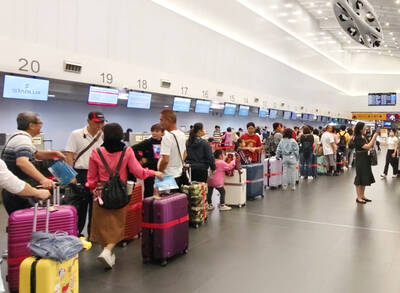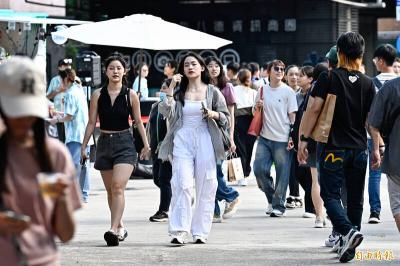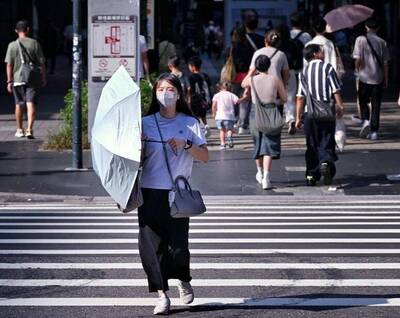Since the 921 Earthquake in 1999, scientists have thrown everything into identifying predictors of the devastating phenomenon, looking beneath the ground and even from space in a bid to improve understanding of the mechanisms responsible.
Standing beside a monitor detecting crust deformations at National Dong Hwa University in Hualien last year, National Central University geophysicist Yen Horng-yuan (
According to Yen, studies of past earthquakes suggest there is an association between the phenomenon of advance crust deformation and the onset of earthquakes.

PHOTO: CHIU YU-TZU, TAIPEI TIMES
"By carrying out continuous monitoring, we can analyze an abundant amount of data to find out where the crust begins to change before the occurrence of an earthquake. This data might be useful for research on predicting quakes," Yen said.
By the end of 2006, another 30 stations will be set up around the country to complete the GPS network, he said.
Taiwan sits atop the junction of the Philippine plate and the much larger Eurasian plate. The former is slowly being forced beneath the latter under the northern stretches of the country. The process, referred to by seismologists as subduction, is also being monitored by local geophysicists.
Since August 1998, Lee Jian-cheng (李建成), an associate research fellow at Academia Sinica's Institute of Earth Sciences, has measured crust change with creepmeters set up at Tapo Elementary School in Taitung County, which lies on the active Chihshang Fault (池上斷層).
Creepmeters measure the displacement between areas located on opposite sides of a fault.
Lee said that research suggests the Philippines and Eurasia plates are converging at a speed of 8cm per year. However, Lee's continuous monitoring of the plate suture zone in the Huatung Valley connecting Hualien and Taitung suggests that the fault has contracted between 15cm and 20cm annually over the past five years.
"We are seeing significant fault activity here. So we will continue to study how the fault interacts with others nearby in the valley," he said.
The 200km-long Chihshang Fault is only one of seven active faults to have been discovered in the Huatung Valley. In 1951, two earthquakes resulting from dramatic fault activity here ruptured the surface and changed its topography all the way from Hualien to Taitung. At some locations, the land was raised by 75cm.
To better understand these faults' behavior, National Taiwan University geosciences professor Chen Wen-shan (
"Faults in this valley are regarded by scientists as the most active in Taiwan. By analyzing layers in the trenches we can study the old earthquakes that they caused, and we might develop ideas on predicting future activity," Chen said.
Prior to the 921 Earthquake, which claimed more than 2,400 lives, most Taiwanese had grown less concerned about the occurrence of a devastating temblor.
But a number of earthquakes of similar destructive force did occur earlier last century. The 7-magnitude Meishan Earthquake in 1906 killed more than 1,250 people in the country's southwest. A 7.4-magnitude earthquake in 1935 centered in the Hsinchu-Miaoli area killed over 3,200 people; a 6.5-magnitude aftershock then killed another 2,700.
In the wake of the 921 Earthquake, which also injured more than 8,700 people and left 100,000 people homeless, the National Science Council boosted funding for earthquake-related research. Seismologists, geologists and physicists have since teamed up on innovative projects in a bid to discover signs of when the next one will strike.
Scientists have for years speculated that electromagnetic phenomena might be connected to seismic activity. Now, local physicists have decided to look to space to gather more clues.
Liu Jann-yenq (
After analyzing data of more than 300 earthquakes in Taiwan between 1994 and last year with magnitudes greater than 5, Liu found that for 70 percent of the quakes, ionospheric electron density fell sharply to around 65 percent of the normal level some time in the five days before the temblor.
Liu said that if the magnitude was 6 or higher, around 80 percent of sampled quakes had the same effect.
"We're only trying to find precursors to earthquakes. It doesn't mean we've already established a theory for a mechanism of earthquake prediction," Liu said.
However, he said, the drop in ionospheric electron density did not correlate entirely with the occurrence of earthquakes because other causes of change in electron density are known to exist.
Chen Chau-huei (陳朝輝), a seismologist at National Chung Cheng University, told the Taipei Times that local resources for seismology research remain limited. He said there were only 30 professionals delving into earthquakes.
"Actually, Taiwan can be a leading focus of seismological research because the environment in which we live is actually a natural museum for earthquakes," Chen said.

Three Taiwanese airlines have prohibited passengers from packing Bluetooth earbuds and their charger cases in checked luggage. EVA Air and Uni Air said that Bluetooth earbuds and charger cases are categorized as portable electronic devices, which should be switched off if they are placed in checked luggage based on international aviation safety regulations. They must not be in standby or sleep mode. However, as charging would continue when earbuds are placed in the charger cases, which would contravene international aviation regulations, their cases must be carried as hand luggage, they said. Tigerair Taiwan said that earbud charger cases are equipped

Foreign travelers entering Taiwan on a short layover via Taiwan Taoyuan International Airport are receiving NT$600 gift vouchers from yesterday, the Tourism Administration said, adding that it hopes the incentive would boost tourism consumption at the airport. The program, which allows travelers holding non-Taiwan passports who enter the country during a layover of up to 24 hours to claim a voucher, aims to promote attractions at the airport, the agency said in a statement on Friday. To participate, travelers must sign up on the campaign Web site, the agency said. They can then present their passport and boarding pass for their connecting international

Temperatures in northern Taiwan are forecast to reach as high as 30°C today, as an ongoing northeasterly seasonal wind system weakens, the Central Weather Administration (CWA) said. CWA forecaster Tseng Chao-cheng (曾昭誠) said yesterday that with the seasonal wind system weakening, warmer easterly winds would boost the temperature today. Daytime temperatures in northern Taiwan and Yilan County are expected to range from 28°C to 30°C today, up about 3°C from yesterday, Tseng said. According to the CWA, temperature highs in central and southern Taiwan could stay stable. However, the weather is expected to turn cooler starting tonight as the northeasterly wind system strengthens again

Taiwan sweltered through its hottest October on record, the Central Weather Administration (CWA) said yesterday, the latest in a string of global temperature records. The main island endured its highest average temperature since 1950, CWA forecaster Liu Pei-teng said. Temperatures the world over have soared in recent years as human-induced climate change contributes to ever more erratic weather patterns. Taiwan’s average temperature was 27.381°C as of Thursday, Liu said. Liu said the average could slip 0.1°C by the end of yesterday, but it would still be higher than the previous record of 27.009°C in 2016. "The temperature only started lowering around Oct. 18 or 19